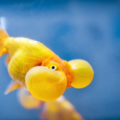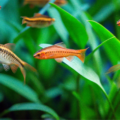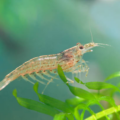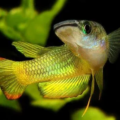Here’s a list of our 14 expertly selected Corydoras Catfish for your hobbyist delight and viewing pleasure in your home aquarium. This article will introduce each Cory, and link to a more detailed outline of its care.

Looking for the perfect freshwater Corydoras guide to begin your journey? Help is right here at your fingertips!
Corydoras catfish, also known as cory catfish, are no strangers to aquarists who prefer small, peaceful fish that are hardy, friendly, and incredibly attractive; after all, one of the top goals of any freshwater fish hobbyist is to enhance the visual appeal of their tanks and homes.
But that’s not all Corydoras catfish have to offer; they also play an essential role as aquarium bottom-dwelling fish who clean up leftover food residue, waste, and detritus. Join us as we take you through their fascinating history and the 12 types of Corydoras catfish.
Quick Sidenote: Do you want to watch this article instead of reading it? Checkout the highlight video below from our YouTube Channel (Or read the more detailed article below), be sure to Subscribe For More Great Fishkeeping Content:
Pepper Corydoras

This Corydoras is a popular and beginner-friendly catfish that basks in its speckled gray and black color pattern. If you’re low on experience with Corydoras, keeping the Pepper Corydoras is great for building your experience and confidence.
The sociable nature of this speckled aquarium catfish makes it the perfect fit for community tanks with a variety of peaceful fish as inhabitants. For Pepper Corydoras care, soft substrate, clean water, and a balanced diet make up their ideal habitat.
Panda Corydoras

Incoming nostalgia! This will likely remind you of the good old Kung Fu Panda. The Panda Corydoras appearance is a wonder to behold with its distinctive white or pale body with black patches designed to add a touch of elegance to any home tank.
Due to its gentle temperament, this small, peaceful catfish is ideal for community tanks. It will survive for years under stable water parameters and grow to reach 2-3 inches. The Panda catfish is a popular Corydoras species, which means getting your hands on them won’t be such a hassle.
Read more on Panda Corydoras hardiness here!
Gold Laser Corydoras

The Gold Laser Corydoras is celebrated for its vivid golden stripe that adds brightness and blinding shine of bling to any aquarium. It is a community-friendly catfish with a relatively easy care level, making it suitable for both novice and experienced hobbyists.
- Unique Traits: The peaceful social behavior of this golden striped Corydoras and its preference for living in groups add to the visual impact of aquariums. There’s no better sight than a school of these golden beauties swimming together on a sunny summer morning.
- Gold Laser Corydoras care: A balanced diet, fine substrate, and stable water conditions contribute immensely to the well-being of this fish and help maintain their radiant color.
Julii Corydoras

Julii Corydoras’s pattern contains intricate black spots and lines on a silver body, giving it a massive visual appeal in any home tank. We promise you’ve never seen this before!
This spotted freshwater catfish can grow up to 2-3 inches and will survive for 5+ years in slightly warm, clean water with stable parameters. Make sure to keep the pH levels between 6.5 and 7.8 and the temperature between 73-790F.
It is highly compatible with similar-sized tank mates, so expect a peaceful environment when you put this aquarium fish with unique markings in a tank.
Sterbai Corydoras

If you’re looking for the right aquarium catfish for planted tanks, you should familiarize yourself with this species.
Sterbai Corydoras is famous for its unique orange pectoral fins and spotted body, making it a striking addition to any community tank. Their bright color varies from brown to black, with white dots all over their scales and fins.
This orange-finned Corydoras has become a popular addition to planted tanks due to its hardiness and easy handling. Sterbai Corydoras care is easy for both beginners and expert aquarists and is suitable for various setups.
Albino Corydoras

The Albino Corydoras is a variety of the Bronze Corydoras with a pale or pinkish-white body. It has achieved renowned status in a tank as an active bottom cleaner.
In addition to their unique colors, unlike other cory, this white bottom-dwelling fish is a great choice for beginners who want small, peaceful fish that can exist in a tank with various other fish species.
Albino Corydoras are easy-care aquarium catfish that can grow up to 2-4 inches and have a 5-year lifespan. They are best kept in schools in a tank with a minimum size of 20 gallons.
Bronze Corydoras

Are you looking for a catfish that is easy to care for and one of the most common Corydoras species? The Bronze Corydoras, or Green Cory, should be at the top of your list.
Bronze Corydoras’ appearance features a golden bronze color with a prominent darker stripe running along the sides of the fish. Iridescent flecks of green can be found around the fish’s head and along the darker stripes.
This beginner-friendly catfish measures between 2 and 4 inches and can live up to 8 years as an adult. It is ideal for beginners due to its hardiness and adaptability to various water conditions.
Bandit Corydoras

This masked Corydoras catfish stands out with a black mask pattern covering its eyes and flowing down its back to create an eye-catching feature.
This unique aquarium catfish fills any tank with delight but often encounters sensitivity to water conditions, hence the need for a well-maintained tank with clean, soft water.
Bandit Corydoras care also involves providing plenty of hiding spots with plants and driftwood to create a cozy catfish habitat.
Dwarf Corydoras

Dwarf catfish is a small Corydoras species known for its popular schooling behavior, which can serve as a viewing pleasure for watchers and also has a high tolerance for similar-sized tank mates. This catfish displays a soft silver-gray body with soft, darker markings along its sides, giving it a classy and attractive demeanor in the aquarium.
If you’re an aquarist in need of a nano tank catfish that is peaceful and hardy, look no further than this absolute beauty. As for Dwarf Corydoras care, you must maintain clean, stable water, provide fine substrate to protect their barbs and offer a varied diet of small, sinking foods.
Adolfo’s Corydoras

This colorful Corydoras catfish is both beautiful and distinctive, making it a no-brainer choice for aquarists looking to add an appealing touch to their tanks. The aquarium fish with distinctive markings is widely admired for its unique orange head and bold black stripe flowing through its shimmering silvery white body.
However, due to Adolfo’s Corydoras characteristics, it is more delicate than its peers and thus requires a stable, peaceful tank environment and careful monitoring of water parameters. This demanding care needs implies that the species is well suited for experienced aquarists alone and may be extremely difficult for beginners to manage.
Three Stripe Corydoras

An equally striped freshwater catfish, the Three Stripe Corydoras is often mistaken for Julii Corydoras due to their similar markings. Its physical appearance is straight to the point; you will find three dark stripes along its body up to the head that are more connected in a long string, giving it a maze-like outlook.
This catfish is a popular choice among Corydoras enthusiasts as an aquarium fish with bold patterns and an easy care routine. Speaking of Three Stripe Corydoras care, provide a soft substrate, peaceful tank mates, and maintain stable water conditions to get the best function out of your aquatic pets.
Similis Corydoras

An epitome of beauty is the best way to describe spotted Corydoras for aquariums. This catfish’s body is home to a brilliant pattern of dark spots scattered over a silvery gray body, adding glitz and glamor to any aquarium.
This vibrant aquarium catfish is a great choice for community tanks, especially when kept alongside similar-sized fish to bolster its lively nature and preference for thriving in groups where it’s natural behaviors and pleasing movements are best experienced.
Building the perfect Similis Corydoras profile includes adding fine substrate to the tank, introducing peaceful tank mates, and creating a spacious environment to accommodate their active and sociable lifestyle.
Pygmy Corydoras

Holding the prestigious record for the world’s tiniest catfish, this South American schooling Corydoras species has become every aquarist’s favorite because of its unique swimming style and gorgeous appearance. They usually prefer swimming mid-water by flapping their fins and occasionally come to the surface for fresh air, a sharp detour from the bottom-dwelling habit of most catfish.
The nano aquarium catfish’s body is made up of a silver outline with a dark horizontal line that comes together to create a beautiful contrast. Pygmy Corydoras’ details also include their big black eyes and ever-curious whiskers, which almost look like a mustache. This fish typically grows to a maximum length of 0.9-1 inch (2.5cm).
Venezuelan Corydoras

The Venezuelan Corydoras is a colorful Corydoras catfish known for its eye-catching orange and dark color pattern, making it a standout among Corydoras species.
- Unique Traits: The freshwater catfish is also the perfect beginner Corydoras species that exhibit a peaceful temperament suitable for community tanks. It is also a hardy fish with extensive adaptability to different tank environments.
- Venezuelan Corydoras care: Healthy water parameters, regular water changes, and curating a blanched diet filled with protein-rich meals are all essential parts of this catfish’s care regimen.
Conclusion
From Pygmy catfish to Bandit catfish, pale-bodied Albino catfish, and the ever-dazzling Bronze catfish, the astonishing beauty of the Corydoras species and compact size have earned them a spot on the list of one of the most popular catfish types for aquariums.
However, choosing Corydoras for aquariums is not a picnic. Despite their size, other intricacies matter, such as the tank size, the aquarist’s experience level, as some Corydoras, like the Adolfo, demand a lot more attention than their peers, and aesthetic preference, whether you’re a minimalist or a lover of extravagant tank setups, there’s always a Corydoras for you.
Our guide to Corydoras species is a lifesaver; with it, you can quickly learn to become a master aquarist.












8 thoughts on “14 Types of Corydoras Catfish: A Guide to Hardy and Playful Freshwater Fish”